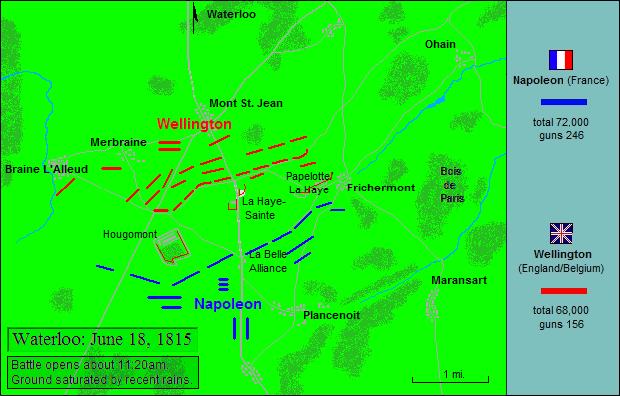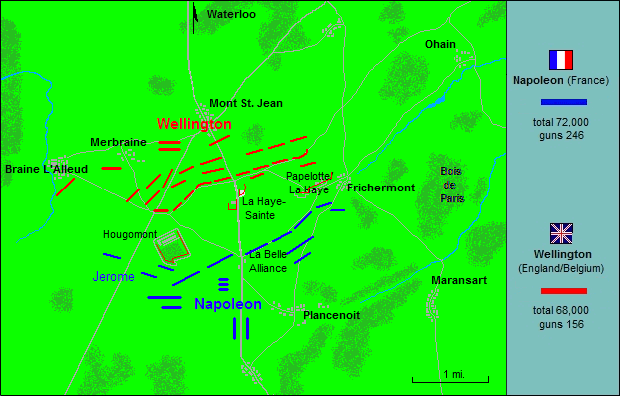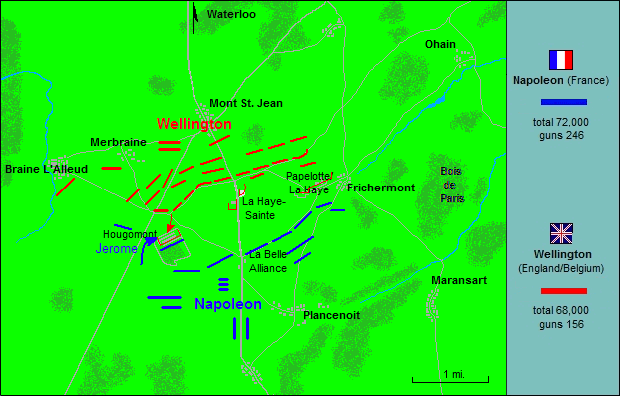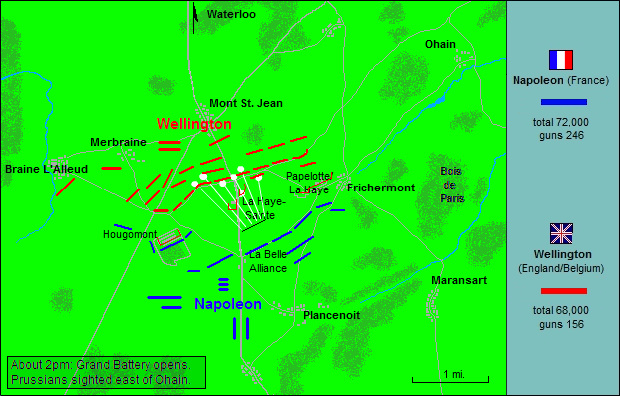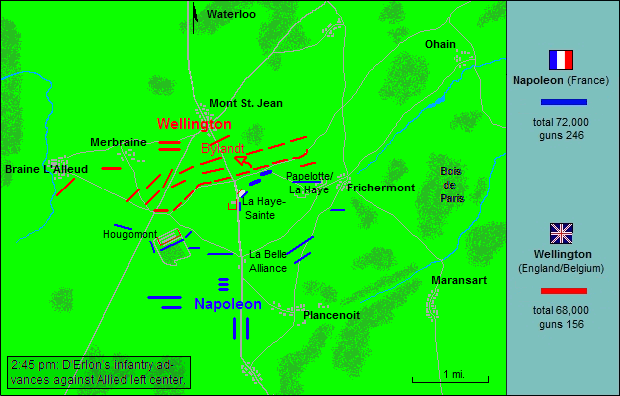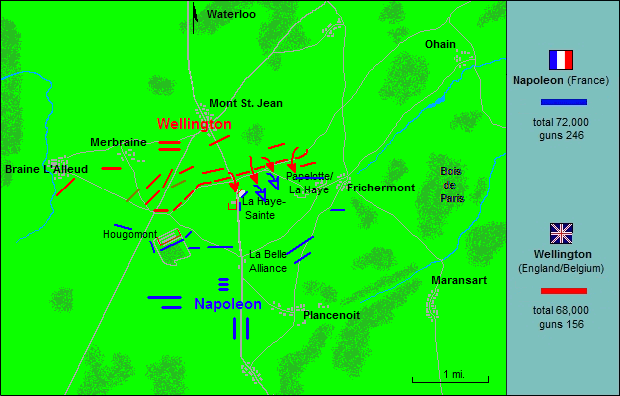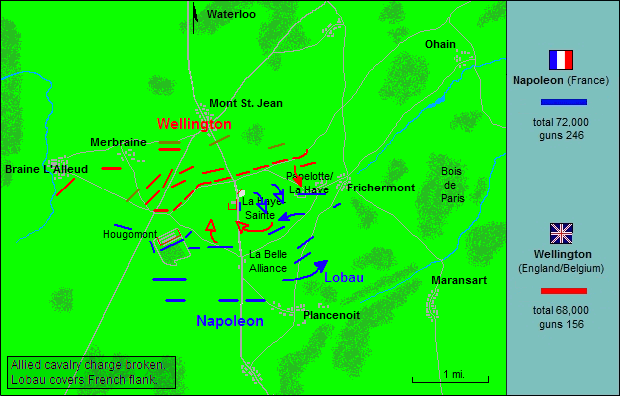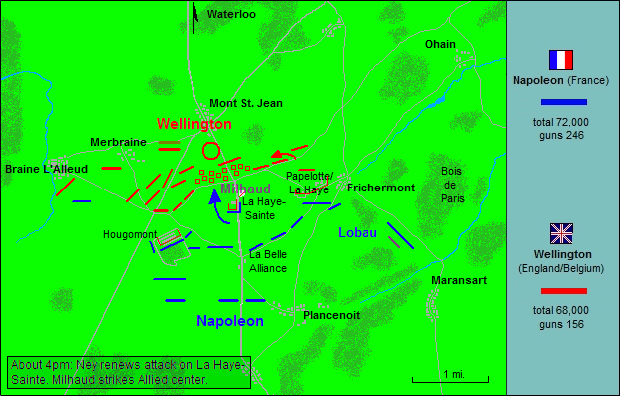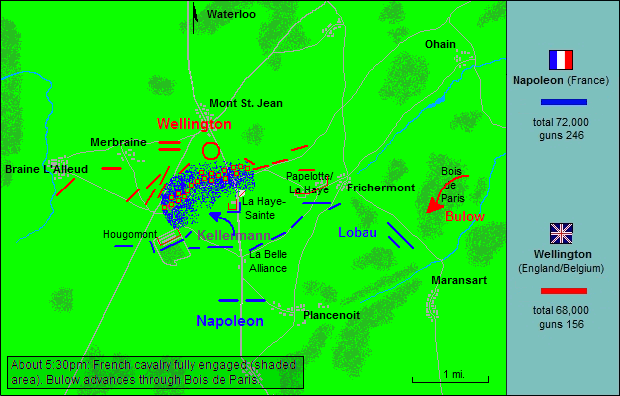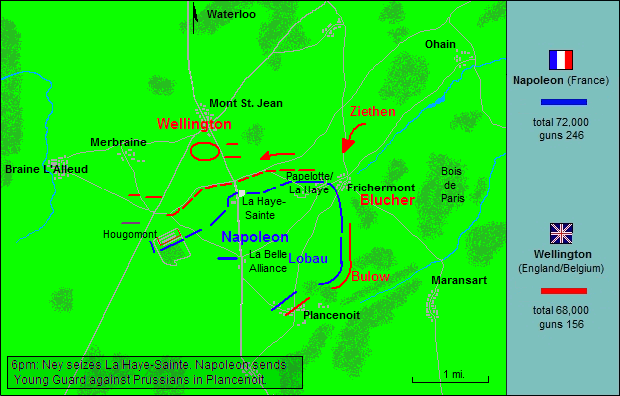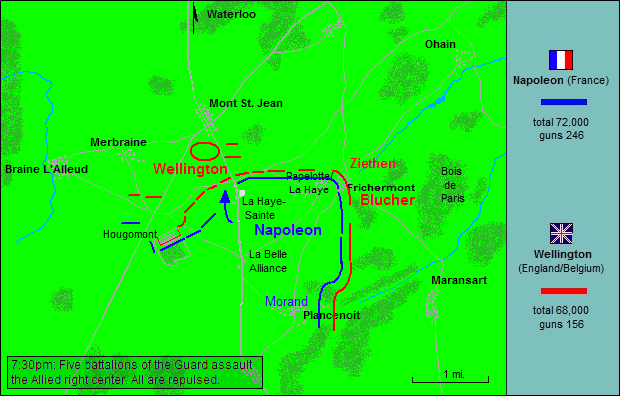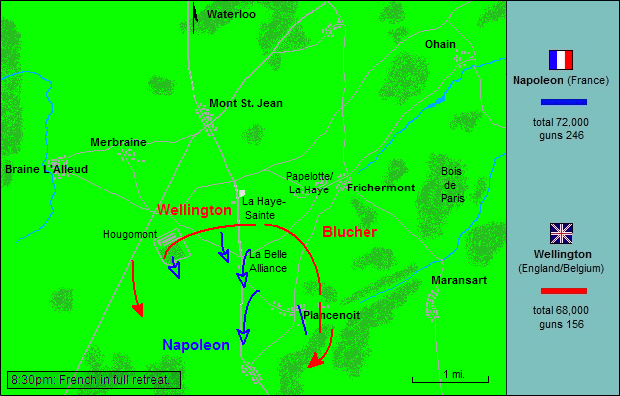It has been a damned nice thing–the nearest run thing you ever saw in your life… By God, I don’t believe it would have been done if I had not been there.
–Wellington, to his brother
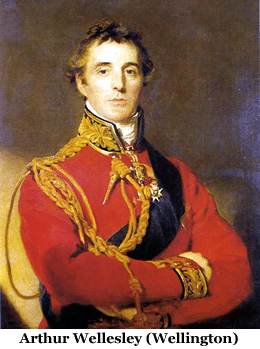
From the ridge at Mont St. Jean, Wellington’s troops watched the arrival of the French rear-guard over their morning coffee. With the enemy’s forces still en route and the intervening fields too sodden to support cavalry or artillery, any serious operations were hours away, and thus a day that was to be full of terrors began in eerie, contrapuntal calm. Insofar as any of the Allied soldiers knew or were given to understand the designs of their commander, it was clear the coming fight would be defensive in nature. On the Allied right, a large farm complex known as Hougomont dominated the approach to the army’s western flank, its walled enclosure providing ready-made fortifications for a crack force of British troops. About three-quarters of a mile to the east a somewhat smaller farm, La Haye Sainte, likewise readily-defensible and manned by veterans, dominated the center of the battlefield, a nearby sandpit providing a natural sniper’s nest on its flank. Another mile farther east the settlements of Papelotte and La Haye were held by Dutch troops and served to anchor the Allied left. Behind these forward defenses, the bulk of the Anglo-Dutch forces lay along the crest and northern slope of the ridge, where their exposure to the enemy’s artillery was much reduced by the oblique angle of the ground.
Though the coming battle would be Wellington’s first against Napoleon, his long experience in Spain made him no stranger to the aggressive tactics of the French. And while he had been forced to fall back on the position in haste following the collapse of his Prussian allies, there was nothing haphazard about his choice of ground. For some weeks he had been studying the ridge at Mont St. Jean with an eye to its potential for just such a stand in defense of the Belgian capital, and the disposition of his forces was carefully designed to present the enemy with a decidedly awkward proposition: either capture the three strongholds from tenacious defenders and in the face of concerted artillery fire from the ridge or pass them by in an assault on the ridge itself and be raked in flank and rear by their garrisons.
Having surveyed the enemy’s dispositions the previous evening, Napoleon settled on a plan of attack as audacious as Wellington’s defensive arrangements were shrewd. Recognizing that his opponent had taken particular care to guard his right flank, the Emperor proposed to create a diversionary attack on Hougomont in hopes of drawing additional enemy forces to the scene, at which point he would launch a massive frontal assault against the enemy left along the ridge east of the Brussels highway. Following a preliminary artillery barrage, D’Erlon’s entire corps would advance along a broad front and occupy the crest of the ridge, at which point the French artillery would move forward and enfilade the enemy line with grape and canister shot. Next, Milhaud’s heavy cavalry would penetrate the enemy’s right wing, sweeping into his rear areas and breaking up any secondary defenses. Whatever organized resistance remained would be shattered, as at Ligny, by a final attack of the Imperial Guard.
In essence, the plan was similar to the one Napoleon had employed at Borodino. As on that earlier occasion, there would be no dramatic flanking movements and little effort of any kind to maneuver the enemy out of his strong position (the trademarks of virtually all of his previous successes); instead the French troops, their morale soaring in the wake of Ligny, would engage the enemy in straight-ahead, smash-’em-up fighting, relying on brute force and weight of numbers to win the day. As at Borodino, the plan reflected a combination of supreme self-confidence and desperate urgency, revealing something of the larger political dilemma in which Napoleon found himself. Though the risks inherent in such an all-out offensive were high, only a quick and decisive victory promised to maintain the tenuous momentum of his return to power, and in this sense, the strategy was uniquely appropriate to his circumstances. With the whole of Europe rearming against him, there was no time to lose, and any hint of hesitation or self-doubt only threatened to increase the odds against him. Breakfasting with his staff at his headquarters at Le Caillou, he was full of confidence. “We will sleep tonight in Brussels,” he assured those in attendance.
Marshal Soult was not so sure. Having fought against Wellington in Spain, the new chief of staff (Berthier had declined to rejoin the Bonapartist cause upon the Emperor’s return and was now dead, an apparent suicide) had acquired a healthy respect for the Duke’s generalship as well as the staying power of British troops and made bold to voice his reservations. Napoleon dismissed his concerns as defeatist, pointing out the large numbers of unreliable foreign auxiliaries that made up the Anglo-Dutch army. Though Wellington’s position was a strong one, his patchwork forces would not stand up to the pounding they were about to receive, he argued. Like the Prussians at Ligny, any redcoats who might withstand the initial onslaught would be trampled into the sod by the Guard.
Regarding the results of the previous day’s fighting, however, he was mistaken. Though routed, Blücher’s army had not been destroyed, and while Napoleon was focusing his attention on the Anglo-Dutch army at Mont St. Jean, some ten miles to the east the Prussians were reassembling at Wavre. In their flight north from Ligny, they had been joined by a fresh corps under Friedrich von Bülow, and despite the loss of some 25,000 casualties and another 12,000 deserters, the army remained essentially intact. By the morning of the 18th Blücher himself, though wounded, was back in the saddle, having lost none of his wonted pugnacity. To an aide bound for Wellington’s headquarters, he said: “I beg you tell General Wellington, in my name that, ill as I am, I am going at the head of my troops, to fall on the right wing of the enemy when Napoleon commences the battle.”
Meanwhile, having failed to keep pace with the retreating Prussians, Marshal Grouchy, whose job it was to prevent such a link-up, had little direct knowledge of the whereabouts of the various enemy corps, which he assumed had lost much of their organization. By 10:00 a.m. he was in Walhain, where a local civilian assured him that the Prussian main body had spent the night well east of Wavre and was on its way to Louvain. When another report confirmed that no Prussians had been found between Walhain and the Dyle River, Grouchy was reassured, and, far from apprehending any danger, sent a message to Napoleon requesting orders for the following day. In fact, Grouchy’s information was accurate, yet his assumptions were false. Bülow’s men had indeed camped east of Wavre but had risen before dawn, and by 5:00 a.m. were streaming westward across the Dyle bridges, bound for Chapelle St. Lambert and a union with Wellington’s army. By mid-morning the other three Prussian corps had reformed in the vicinity of Wavre and were preparing to follow Bulow’s lead. Thus, the apparent absence of Prussians between Walhain and the Dyle was not–as Grouchy assumed–evidence of the army’s complete dissolution, but rather an indication of its continued integrity, and should have been construed as a cause for alarm.
Meanwhile, unaware of the looming threat to his flank, Napoleon had postponed the start of his opening attack a second time (his original plan calling for an advance at dawn). In front of D’Erlon’s corps to the right of the Brussels highway some 80 guns had been massed along a narrow rise of ground. Much depended on their effectiveness in breaking up and demoralizing the enemy’s formations, and as the still-sodden ground threatened to deaden the impact of the shells, the French emperor opted to await drier conditions. In the meantime he made a final inspection of the army, parading before the waiting formations in a carefully choreographed performance designed to excite the legendary valor and élan of his waiting troops. Astride his favorite white charger and instantly recognizable in his grey campaign coat and bicorn, he rode along the lines as wildly enthusiastic cheers of “Vive L’Empereur!” followed his progress in a rolling chorus. In the brief eternity before battle, well aware of the terrors that awaited them in the coming firestorm, the French once again partook of the ineffable communion that lay at the heart of his legend, their fear of death superseded by a greater thirst for glory.
Then, about 11:20, it started, the guns in front of Hougomont opening fire and a brigade of French infantry advancing upon the woods immediately south of the farm’s main enclosure. Here, a battalion of German troops stood ready to oppose them, and soon a steady rattle of musketry announced the progress of the attack as the larger French force drove the defenders through the woods and back behind a six-foot wall surrounding the large chateau, its gardens, and outbuildings. As the attackers came up against an additional force of British Guards, their efforts to storm the wall were repulsed with heavy losses, at which point Prince Jérôme ordered another of his brigade’s into the fray. Coming into line west of the complex, the fresh assault troops went forward in a determined rush, storming the walls and battering their way into the main gate at the northwest corner of the enclosure. Their success was short-lived, however, as the British defenders managed to reclose the gate even as British artillery units on the ridge found the range of the attackers in front of the exposed northern approaches to the complex, driving them off in confusion. As both sides continued to feed more troops into the fight at Hougomont, what had begun as a mere diversion grew into an increasingly bitter engagement. Taking full advantage of their highly defensible position, the British got much the better of the exchange, forcing the enemy to commit (and lose) a disproportionate number of troops. By 1 p.m. the attack had drawn in all of Jérôme’s divisions and part of Foy’s, and yet the farm’s defenders held on, keeping the enemy at bay with a hail of small-arms fire while batteries along the ridge swept the surrounding fields and pounded the woods south of the chateau, from which French wounded could be seen issuing in a steady stream.
Napoleon, meanwhile, was preparing to launch his main attack against the Allied left center, when suddenly he hesitated. Peering through his telescope at the ridge that was soon to be enveloped in the smoke of battle, he saw what seemed to be a dark shadow falling across the landscape near Chapelle St. Lambert, some three miles distant. Puzzled, he suspended his attack for the moment and sent a squadron of cavalry to investigate. The strange sighting was evidence of a large body of troops, but whose? According to reports, Grouchy had engaged the Prussian rearguard at Wavre, yet a recent dispatch had included unsettling news; the main body of the Prussian army, it seems, was retiring not on Louvain as was originally supposed, but on Brussels. The update portended nothing good, and when a captured Prussian hussar was brought before him with a dispatch from Blücher to Wellington, Napoleon’s worst fears were realized. Massing west of St. Lambert, Bülow’s Prussians were preparing to advance against the French flank, and the rest of Blücher’s army would soon be on the march from Wavre.
The implications were staggering, causing even Napoleon, whose calm in the face of crisis was legendary, a moment’s alarm. Before him lay a crucial decision–whether to proceed with the planned assault in the hope of defeating Wellington before the Prussians could reach the field, or disengage and seek battle under more favorable conditions somewhere to the west, in which case his initial success at Ligny and the chance to maintain the initiative would be lost. The larger political implications of a withdrawal threatened another prolonged war of attrition as the combined armies of Europe once again assembled to run him to ground. On the other hand, there was still a chance that his impending attack would carry the day. The Prussians would take at least three hours coming into line, maybe more. If all went well, in three hours D’Erlon’s corps would be firmly established on the crest of the ridge, at which point the rest of Wellington’s position would become untenable. Besides, Grouchy’s 33,000 were still in the offing, with which to tip the scales. Thus, he took a gambler’s chance, risking everything in an all-out effort to keep time on his side. A rider was quickly dispatched to Grouchy with an urgent order to rejoin the army at once, and about 1:20 p.m. the guns of the Grand Battery opened with a terrifying roar.
By this time, however, the odds against the French had already lengthened considerably. Earlier in the day, hearing the distant rumble of the attack on Hougomont as far away as Walhain, General Gerard had pleaded with Marshal Grouchy to march to the sound of the guns. Had he moved quickly, Grouchy might have caught up with the Prussian columns by advancing directly on St. Lambert. Despite Gerard’s heated protests, however, he returned to an infamous lunch of strawberries, content to pursue his advance on Wavre as ordered. It was not until 12:30, when his cavalry commander, Exelmans, reported large numbers of Prussians in Wavre, that he sensed the urgency of the situation. Even then, instead of marching west to protect the main army’s flank, he continued north in a belated effort to engage the Prussian rearguard. At that point, for all of its immediate effectiveness as a flank guard, his corps–representing nearly a third of Napoleon’s entire force–might as well have been on the far side of the moon.
Meanwhile, the massed French artillery continued to pound the ridge at Mont St. Jean as D’Erlon’s corps prepared to advance. About 1:45 the guns of the Grand Battery fell silent and some 20,000 men stepped off in a series of massive columns with a line of skirmishers in front and heavy cavalry in either flank. Despite damp ground and knee-high grain, the attacking columns swept forward like a vast, irregular line of surf extending from Papelotte on the right to a point well west of the central farmhouse, roughly a mile in length. At its approach, enemy skirmishers were driven out of the enclosures surrounding La Haye-Sainte, and a brigade of enemy reinforcements advancing to the support of the beleaguered farmhouse was thoroughly routed by French cuirassiers. Meanwhile, on the opposite end of the line, the Netherlanders were pushed out of Papelotte as all across the intervening ground the blue wave swept onward toward the crest of the ridge.
The next obstacle in its path was a single Belgian brigade (Bylandt’s) that had remained on the forward slope of the ridge while the rest of the army was positioned at or behind the crest. Already decimated by direct exposure to the French artillery barrage, the Belgians fired a last, ragged volley at the oncoming wave and bolted for the rear, where they would remain for the rest of the day. Now Donzelot’s troops continued upslope through the litter of the fleeing enemy, while ahead of them on their right Marcognet’s division reached the crest of the ridge and continued across the Ohain road, pressing the Allied line back before them. By sheer weight of numbers, the French attack seemed destined to carry all before it.
Meanwhile, however, two British brigades (those of Kempt and Pack) had come forward into the gap created by the departure of Bylandt’s men. Forming an extensive firing line, they waited until Donzelot’s column had come within twenty yards before delivering well-aimed volleys into the oncoming mass, in which individual battalions were arrayed as many as sixteen ranks deep. The shortcomings of the densely-packed French formations quickly became apparent as the rolling crash of British musketry sent a prolonged, agonized shiver through the entire mass. Momentarily stunned, the column came to a halt just short of the Ohain road and began to redeploy in line of battle. At this point, the seemingly irresistible juggernaut of the advancing column was transformed into a large mass of flustered men struggling to perform complicated maneuvers under heavy fire.
Quickly capitalizing on the enemy’s confusion, the redcoats came on in a bayonet charge, rushing forward to engage in a savage hand-to-hand brawl. Caught in a tactical blunder, the French fell back to a point just below the crest of the ridge, where they held fast, engaging their pursuers in a bitter firefight. At this point Wellington forced the issue, ordering a large force of heavy cavalry forward against the faltering French attack. Charging over the crest of the ridge, the British horsemen swept forward in two columns. West of the Brussels road, Somerset’s Guard cavalry crashed into and through a brigade of cuirassiers but were soon repelled by the solid ranks of Bachelu’s infantry near La Haye-Sainte. Meanwhile, east of the highway, three regiments of the Union Brigade under Sir William Ponsonby rushed downslope upon the largely disorganized battalions of Donzelot’s division, penetrating their ranks and breaking them apart. Coming hard upon their recent setback, the sudden appearance of enemy horsemen in their midst proved too much for Donzelot’s men, who turned and ran in abject panic, leaving Marcognet’s division exposed in flank and rear. As the British horsemen swarmed around Marcognet’s men, they too broke and ran, and in a matter of moments, the entire French front had begun to ebb away.
Having repelled the enemy assault with a series of well-timed counter-strokes, the Anglo-Dutch army had all but decided the issue. As the triumphant British horsemen drove home the attack, however, their very success lured them on to disaster. Carried away by the euphoria of the chase, Ponsonby and much of his command raced ahead of the fleeing French infantry in a daring assault upon the great battery in front of the French line. Pounding across the open fields between the two armies, the charge presented a magnificent spectacle, and, seeing them come, Napoleon himself expressed his admiration. At the same time, however, he ordered a force of lancers and cuirassiers to intercept them, and no sooner did the onrushing attackers fall upon the French gunners than they were themselves set upon in front and flank. Forced to wheel about and race back across the field, the British heavies found themselves caught in a tactical blunder every bit as devastating as that which had befallen Donzelot’s infantry. Far from the safety of their own lines, their horses blown, they were readily overwhelmed by the French counter-attack, and many–including Ponsonby himself–were cut down before they could make good their escape.
As D’Erlon’s shattered divisions staggered back to their original positions and the survivors of the British charge made their way back to the ridge, a lull in the fighting ensued. Napoleon, meanwhile, had no time to lose; with every passing moment, the odds against a French victory continued to mount. But for the windfall by which much of the enemy’s cavalry had fallen into his hands, there would have been little point in carrying on the fight. The sledge-hammer blow with which he had planned to knock Wellington off his feet had itself been shattered with losses of 3,000 men and two eagles. Even if the defeat of Wellington’s army had been his only concern, his prospects were far from bright; add the Prussians to the mix and they became all but hopeless.
Nevertheless, he persisted. Sending Lobau’s corps east to hold off Bulow, he turned his attention once again to Hougomont, which had taken on a larger strategic significance in view of the new threat to his right. If he could capture the farm and turn Wellington’s flank, he might swing his entire line clockwise to confront the combined enemy. Calling up additional artillery, he subjected the farm’s walled enclosure to renewed shelling, and soon the central chateau caught fire, sending thick columns of smoke roiling over the battlefield. Even so, the British defenders held on, driving off every attempt to storm the walls.
Next, having allowed time for D’Erlon’s men to reform on the French right, Napoleon prepared to launch another attack on Wellington’s center, sending Ney forward against La Haye-Sainte with two brigades, one from Donzelot’s division and another from Allix’s. At the same time, a great number of French cavalry were assembled in preparation for a massive advance upon the Allied infantry along the crest of the ridge, an attack that was to go forward following the capture of the farmhouse. By 4 p.m. Ney’s assault had reached the southern perimeter of the farm, but the hard-used French infantry could not force their way into the central courtyard against the stubborn defense of soldiers of the King’s German Legion.
Now French gunners commenced a general bombardment, and a deafening artillery duel erupted all along the line. Enjoying a distinct advantage in numbers of guns as well as gunnery, the French got much the better of the exchange, giving the Anglo-Dutch forces such a vicious pounding that several of Wellington’s brigades withdraw some hundred paces to the rear, where the northern slope of the ridge offered better protection. Meanwhile, members of the French cavalry massed near La Belle Alliance, assuming that the slight displacement of enemy troops portended a general withdrawal, started forward. (While many accounts of the battle suggest that Marshal Ney gave the order for the attack, evidence would later reveal that it may have resulted from spontaneous efforts to straighten the line of Milhaud’s horseman.) In the heat of the moment, the Guard cavalry joined in the attack, and suddenly the battle entered a new phase as masses of French horsemen advanced in successive ranks against Wellington’s right-center, where the Anglo-Dutch brigades quickly formed defensive squares.
Preoccupied with the growing threat to his right flank, Napoleon was not aware of the attack until it was in full career, whereupon he quickly pronounced it premature. Without close infantry support, the advancing columns of cavalry were bound to break up against the squares, at which point they would be subjected to a gauntlet of small arms fire. Nevertheless, he determined to support the attack, sending forward the balance of his cavalry in hopes of thoroughly disorganizing Wellington’s line. Soon the western end of the ridge was swarming with French horsemen, who wrought havoc upon the enemy’s entire right wing. Without infantry support, however, the French troopers charged at the stolid enemy formations only to be balked by unbroken rows of bayonets and shot down by the steady fire of tight ranks of Allied riflemen. And while the attacking horsemen managed to overrun many of the enemy batteries, they had failed to bring the simple tools (hammer and spikes) necessary to render the guns useless. Thus, as the French cavalry fell back below the ridge to regroup, enemy gunners who had taken shelter in the squares during the onslaughts were able to rush forward and reman their guns, firing devastating rounds of grape and canister shot into each fresh assault.
Nevertheless, by penetrating deep within the enemy’s defenses, the combined force of hussars and cuirassiers wrought considerable destruction, enabling the French infantry to move forward in a general assault on the ridge. Shortly after 6 p.m., under the weight of the renewed infantry attack, La Haye Sainte was finally taken in savage fighting, and suddenly the French were poised upon the brink of victory. Surging onto the crest of the ridge and across the Ohain road near the Brussels highway, they pressed forward in a final, all-out effort. On Wellington’s extreme left, the Netherlanders were driven out of Papelotte and La Haye, and only the timely arrival of Ziethen’s Prussians prevented his flank from being turned.
Indeed, despite long delays, the Prussians were at last making their presence felt along the French right. Advancing from the Bois de Paris, Bülow’s corps had driven Lobau back upon the village of Plancenoit and was threatening to cut the Brussels highway in rear of the French position. Sent to Lobau’s rescue, six battalions of the Young Guard crushed the Prussian advance and drove the enemy back in the direction of the Bois de Paris. They would soon reform, however, and the Guard could not be expected to hold out for long against vastly superior numbers.
With approaching dusk beginning to darken the already murky gloom of battle, Napoleon prepared to play his final card. It was now 7:30. Though the day had been full of setbacks and uncertainty, he had at last created the moment of ripeness, when a final, decisive blow promised to topple Wellington’s battered army and send it clattering back down the Brussels highway in defeat. Held in reserve throughout the entire eight-hour ordeal, eleven battalions of his elite corps of veterans, the Imperial Guard, stood ready to decide the issue. On battlefields from one end of the continent to the other, the Guard had earned a reputation as the most fearsome soldiers in the world, the very sight of their distinctive bearskins and grim, mustachioed faces often serving to turn the tide of battle. Two days earlier, they had made the crucial attack at Ligny, precipitating the Prussian collapse and very nearly capturing Blücher himself. There was every reason to believe they would prevail here as they had so often in the past. Assigning six Guard battalions to the coming attack, Napoleon kept five more in reserve in the vicinity of La Belle Alliance. The attacking columns were to aim for the center of the enemy position, where Wellington’s forces had been stretched to the breaking point. Penetrating the enemy line near the Brussels highway, they would be joined on both flanks by General Reille’s regulars, who were to consolidate the breach and bring up artillery to complete the enemy’s destruction. Having explained the details of the impending attack, Napoleon started them forward in person, then passed direct command to Marshal Ney. In a sheltered hollow at the base of the slope, he watched them pass, calling out encouragement. Then he rode off in the direction of Papelotte to bolster his own line against an impending Prussian breakthrough.
In view of Ney’s performance thus far in the campaign, the decision to entrust the impetuous marshal with the crucial attack, like the decision to leave the immediate vicinity of the battle’s climactic moment, would lead to speculation that Napoleon was suffering from a variety of ills ranging from stomach cramps to severe hemorrhoids. In fact, during the middle of the afternoon, while Ney was preparing his attack against La Haye-Saint, the Emperor had actually returned to Rossomme to lie down, and his absence from the field had clearly contributed to the confusion in which the cavalry attack had gone forward prematurely. Now, at a moment when his own fate and that of the army was about to be decided, he would once again be curiously absent. Whatever the reasons, the development did not bode well, and indeed the attack did not proceed according to plan.
Setting out across the smoke-dimmed battlefield in the waning hours of daylight, the Guard battalions advanced from the vicinity of La Belle Alliance in a series of staggered columns, each one behind and slightly to the left of its predecessor. Passing to the left of the central farmhouse, they came under savage artillery fire from the enemy’s remaining batteries on the ridge, and, raked in flank and front, quickly became disoriented. Though the individual battalions were to attack en echelon from right to left, any chance of coordinating their movements on the march had been squandered when–out of a sense of camaraderie, bravado, or sheer impetuousness–Ney opted to join the troops on foot, a decision that would effectively render the operation leaderless. Thus, instead of creating a succession of mutually supportive blows, they came forward piecemeal. Managing to strike the enemy line immediately west of the highway, the two leading battalions smashed their way forward independent of each other and, breaching the line, held on in anticipation of support from Reille’s troops.
Meanwhile, farther west, two of the central battalions had linked up in mutual support. In the fog of battle, however, they had veered well left of the enemy’s center and were making their way toward the most heavily defended stretch of the enemy’s line, behind which Wellington himself awaited the coming attack. Here, a brigade of British Guards had been ordered to lie down amid the standing grain, concealing themselves from the approach of the French. Now, as the advancing enemy columns appeared out of the choking dust and smoke, the British scrambled to their feet, took aim, and poured out a devastating volley in one long, continuous crash. For a brief instant, the dark netherworld of the battlefield was lit up by sheets of flame, whereupon the front ranks of the advancing columns–already torn by deadly blasts of grape and canister–went down in a heap. Stunned, the French struggled to recover and redeploy, but before they could do so Maitland’s Guards were rushing at them behind a thicket of bayonets. Falling back, they reformed their lines farther down the slope and held off the counter-attack with rounds of case shot from their field-guns. Soon, they were moving forward again as Maitland’s men fled before them back up the slope.
Meanwhile, off to their left, the last of the advancing French Guard battalions came up obliquely on Maitland’s position, where they were well-situated to effect a breakthrough. Sometime earlier, however, a British battalion under John Colborne had been ordered out of line and moved well forward, and as the final French column came abreast of their position, they wheeled to the left, swinging their line directly across the enemy’s flank. Though taken by surprise, the French got off a volley, bringing down over a hundred men. The British reply, however, was catastrophic. With their battle line now in position, they sent concerted enfilading fire down the French ranks, withering them. Without a thought of further resistance, the survivors fled back down the slope, leaving the ground littered with bodies, guns, and assorted wreckage. Next, reinforced by two more English battalions, Colborne’s men advanced against the remaining French line in front of Maitland’s brigade, sending a steady fire down the length of their ranks. It would prove the decisive blow. At this point Wellington came forward, his bicorn held high. Waving it three times in the direction of the French line, he signaled a general advance, then rode down to Colborne’s men to urge them forward.
By this time, back at the center of the line, the two Imperial Guard battalions near the highway had come under heavy counter-attack from well-positioned Allied reinforcements. Isolated and exposed (Reille’s fought-out infantry had made a convulsive effort to come up on their flanks only to fall back in confusion), the Guard battalions now came under a barrage of canister fire and, unable to hold on, were likewise driven back down the slope. Thus, at every point, the French attack had been repulsed, and as word of the Guard’s failure swept through the French lines a vast sea-change began to take place from one end of the battlefield to the other. With the Prussians pressing in on their flank and Grouchy’s corps nowhere near the battlefield, the French formations began to collapse and melt away amid cries of “Sauve qui peut!”
Having by now returned to the vicinity of the Brussels highway, Napoleon watched as the setting sun shone through the smoke and clouds, revealing his entire army in headlong retreat, the men abandoning their guns and tumbling back from the ridge, irrevocably routed. Seeking to orchestrate an orderly withdrawal, he formed what was left of the Guard columns into defensive squares south of La Haye-Sainte and sent orders to Lobau in Plancenoit at all costs to keep Blücher from reaching the Brussels highway until the retreating army could pass. Soon he himself was racing back down the highway to Quatre-Bras and safety while the remaining battalions of the Guard stood in squares near Rossomme. Overtaken and surrounded by the combined forces of the enemy, whole units refused to surrender and were shot where they stood.
Meanwhile, Wellington and Blücher met briefly at La Belle Alliance to orchestrate the pursuit, and as darkness fell over the scarred and reeking valley, the trumpets of the Prussian cavalry could be heard continuing the chase to the south. With a final butcher’s bill of over 50,000 dead and wounded men (and another 40,000 horses), the Battle of Waterloo was over.

